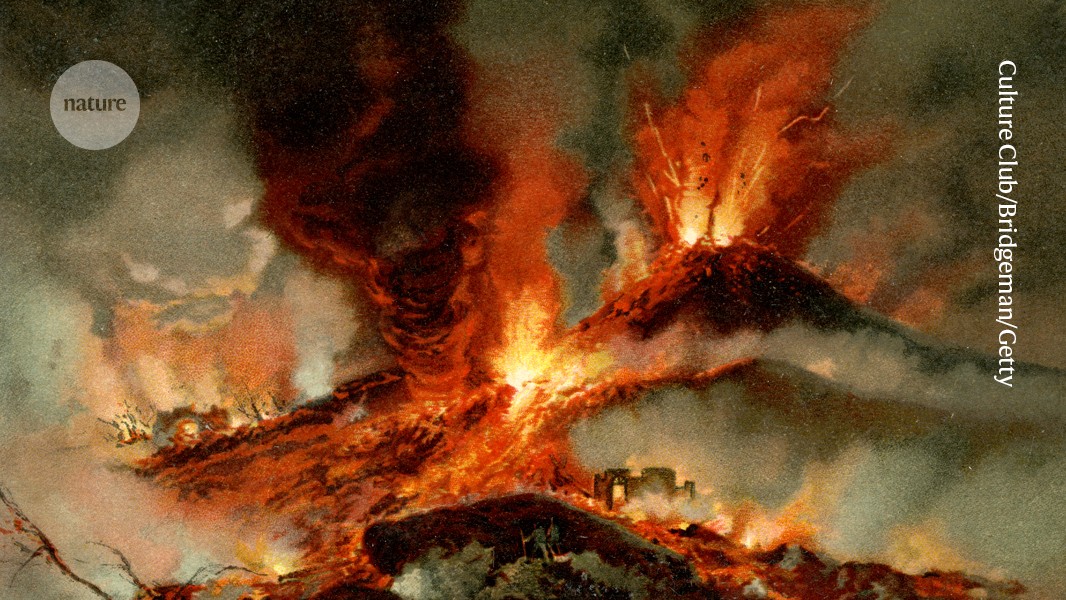First DNA from Pompeii body casts illuminates who victims were

The sex and ancestry of five people who died in the eruption are revealed by genetic material embedded in the casts

The eruption of Mount Vesuvius (artist’s illustration) buried the city of Pompeii, Italy, in at least six metres of volcanic debris.Credit: Culture Club/Bridgeman/Getty
Editor’s note: this article includes a photograph of a plaster cast of a person who died at Pompeii.
Bits of human bone recovered from Pompeii, Italy, have yielded DNA from people who died during the eruption of Mount Vesuvius — and the genetic data are challenging old assumptions about the victims’ identities and relationships1.
Researchers obtained the bone fragments from the plaster casts of people who died in the eruption, which buried the city under ash and pumice in ad 79. The DNA is the first to be recovered from the casts and reveals details about the sex, ancestry and family ties of five individuals.
One narrative debunked by the genetic data, published today in Current Biology, centres on a victim long thought to be a mother who died while holding their child. An intricate golden bracelet on one of the their arms contributed to the attribution of female gender to the individual. The DNA analysis showed instead that the individual was a male and had no familial link with the child.
The reversal shows that DNA can “rewrite history, or the stories of a particular group of individuals”, says co-author David Caramelli, an anthropologist at the University of Florence in Italy.
“They really did a nice job of pointing out that these narratives were highly biased and that these judgments were made without really any scientific data,” says anthropologist John Lindo, who studies ancient DNA at Emory University, in Atlanta, Georgia.
Moment of death
Since excavations of the ruins of Pompeii began in the 1700s, more than 100 plaster casts of the victims’ bodies have been made by pouring liquid plaster in the voids left by the destruction of their soft tissues. Many of these casts still encase pieces of the victims’ bones.
The researchers had the opportunity to collect some of these fragments during efforts to restore 86 of the 104 plaster casts. Samples from five individuals yielded complete or partial genomes. The researchers were very lucky, Lindo says. “Just being exposed to that type of heat would have destroyed a lot of the DNA, and then being mixed environmentally with the plaster later on would have also complicated the situation.”

A conservator works on one of the plaster casts of a person who died at Pompeii.Credit: Salvatore Laporta/KONTROLAB/LightRocket/Getty
According to the DNA analysis, all five individuals were male. The analysis also revealed details of their relationships with each other. For example, the remains of the person wearing the golden bracelet and the child that the person carried were discovered along with two others. Until now, the people in the group were thought to belong to the same family, but the DNA analysis showed no biological connection between them. The findings highlight how unreliable such conventional interpretations, often based on limited evidence, can be, the authors say.
Another interpretation challenged by the new data involves two individuals found in an apparent embrace. They were previously thought to be either sisters or a mother and a daughter, but the genetic analysis now suggests that at least one of them was male.
“What this study does is to remind us that there are indeed myths there to be debunked,” says Steven Ellis, an archaeologist at the University of Cincinnati, Ohio, who has led excavations in Pompeii. He notes that most narratives built around the plaster casts are simplified interpretations designed to boost public interest. Current scholarship about Pompeii doesn’t necessarily accept past interpretations of the casts, but “the plaster casts are an extraordinary symbol of the tragedy that is the story of Pompeii and they’ve always created a splash”, he says.
The DNA analysis also confirmed that Pompeii’s population was genetically diverse: the analysed individuals were descendants of immigrants from the eastern Mediterranean. “We’ve known it from the jewelry that they’re wearing, the cults that they follow, the decorations that adorn the houses,” Ellis says. “But we didn’t really know it from the body cast themselves. Now we do, and that's quite important information.”
doi: https://doi.org/10.1038/d41586-024-03576-y
This story originally appeared on: Nature - Author:Mariana Lenharo


















